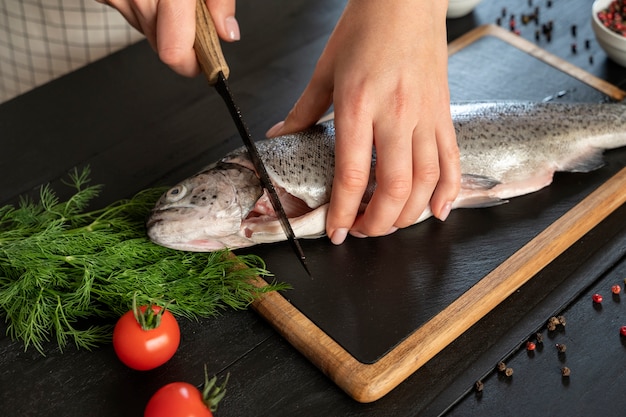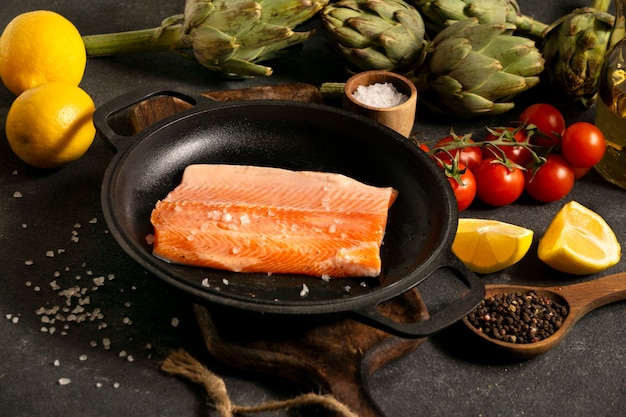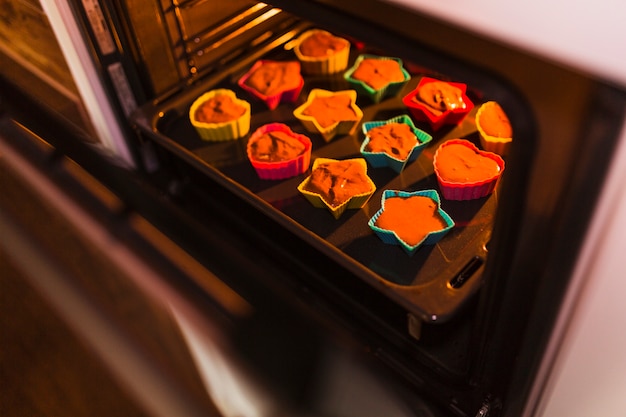There's nothing quite like a perfectly cooked piece of salmon. The flaky flesh, the rich flavour, the beautiful pink hue – it's a real culinary delight. But getting it right can be a bit of a challenge. Too low a temperature and it'll take forever to cook, leaving it dry and disappointing. Too high, and you'll end up with a rubbery mess.
As a senior article editor, I've spent countless hours poring over cookbooks and online recipes, experimenting in my own kitchen, and chatting with chefs to find the perfect oven temperature for salmon. And let me tell you, I've discovered some absolute gems!
So, let's dive in and explore the secrets to oven-baked salmon success together. This is going to be a bit of a journey, but trust me, it'll be worth it!
(Part 1) Understanding Oven Temperatures

The Importance of Temperature: A Key to Success
Okay, before we get into the nitty-gritty of salmon, let’s talk oven temperatures. You see, it's not just about whether your oven is "hot" or "cold." It's about getting it just right to create the ideal environment for your fish to cook evenly and beautifully.
You wouldn't cook a steak at the same temperature as a delicate fish, would you? It's the same principle with salmon. It needs a temperature that's gentle enough to cook it through without drying it out. Too high, and the outside cooks too quickly, leaving the inside raw, or even worse, overcooked and dry.
Types of Ovens and Their Quirks: A Personal Touch
Every oven is a bit different, much like humans. Some run hot, some run cold, and some just seem to have a mind of their own. You might have a fancy new oven with all the bells and whistles, or a trusty old one that's seen it all. Regardless, understanding your oven is key.
If you have a gas oven, you'll need to experiment a bit. They tend to have hotter and colder spots, so don’t be afraid to adjust the temperature slightly as you go. My old gas oven? It was a real character! It often needed a little extra love to get things just right. I remember once, I tried to bake a cake at 350°F (175°C) according to the recipe, but it came out undercooked. I bumped up the temperature to 375°F (190°C) and finally got a perfect bake!
Electric ovens are generally more consistent, but even those can have quirks. My current one seems to run a bit hotter than the manufacturer’s specs, so I’ve learned to adjust my cooking times accordingly. I used to follow recipes religiously, but now I always check the doneness a few minutes earlier than the recipe suggests, just in case!
(Part 2) The Perfect Temperature for Salmon: Finding Your Sweet Spot

The Magic Number: 375°F (190°C)
After countless trials and tribulations (and a few burnt offerings, I'll admit), I've found that 375°F (190°C) is the sweet spot for salmon. It’s hot enough to cook it through quickly, ensuring juicy and flaky results, but not so hot that it dries it out.
Now, I know what you’re thinking: “But what about those recipes that say 400°F (200°C)?” Well, I’ve tried those, and for me, they often lead to overcooked, dry salmon. But, remember, every oven is different!
Experimenting to Find Your Oven’s Sweet Spot: A Tailored Approach
I always recommend experimenting a little. Start at 375°F (190°C), and see how it goes. If you find your salmon is cooking too quickly, reduce the temperature to 350°F (175°C). If it’s taking ages, bump it up to 400°F (200°C).
Remember, it’s better to err on the side of caution and undercook slightly than to overcook and end up with a dry, disappointing meal. Salmon can always be cooked a little more if needed, but you can’t undo overcooking!
(Part 3) The Science Behind It All: Understanding the Salmon's Transformation

Understanding How Salmon Cooks: A Look into the Protein Structure
To truly understand the perfect temperature, we need to delve into a bit of science. Salmon, like most fish, is delicate and cooks quickly. Its protein structure breaks down easily, which is what gives it that flaky texture we all love.
The key is to cook it at a temperature that allows the proteins to break down without becoming rubbery. Too low a temperature, and it’ll take ages to cook, leaving the proteins with time to toughen. Too high, and the proteins will break down too quickly, resulting in a dry and tough piece of fish.
The Role of Heat Penetration: A Culinary Balancing Act
Heat needs to penetrate the salmon evenly to cook it through. A higher temperature ensures faster heat penetration, which is why 375°F (190°C) is generally a good starting point.
However, if you use a very high temperature, the outside of the salmon will cook too quickly before the inside has a chance to catch up, leading to overcooked edges and raw centers. It’s a delicate balancing act! Think of it like a tightrope walker; you need just the right amount of tension to stay balanced.
(Part 4) cooking salmon to perfection: Setting the Stage for Success
Preheating Your Oven: Getting Ready for the Performance
Okay, so we’ve established the ideal temperature, but that’s only half the battle. You also need to preheat your oven properly.
Imagine preheating as preparing the stage for your culinary masterpiece. You wouldn’t put a delicate ballet performance on a cold stage, would you? Likewise, you shouldn’t try to cook salmon in a cold oven.
Preheat your oven to 375°F (190°C) for at least 10-15 minutes before you put the salmon in. This will ensure it’s at the right temperature to cook the fish evenly and quickly.
Preparing the Salmon: Setting the Stage for Flavor
Now, let’s talk about the salmon itself. You can use skin-on or skin-off, it’s up to you. Personally, I prefer skin-on salmon. The skin helps to keep the flesh moist and prevents it from sticking to the pan. Plus, it adds a nice bit of texture and flavour.
Seasoning is key. Salt and pepper are essential, but don’t be afraid to experiment with other herbs and spices. A sprinkle of paprika, a squeeze of lemon juice, or some fresh herbs can really elevate the flavour. I love to add a pinch of smoked paprika and a squeeze of lemon juice to my salmon for a smoky, citrusy flavour.
Finally, don’t overcrowd the pan. Give your salmon some breathing room to cook evenly. If you're cooking multiple fillets, make sure they're not touching each other. This will allow the heat to circulate around them, ensuring they cook evenly.
Cooking Time: A General Guide
The cooking time for salmon will depend on its thickness and whether you’re cooking it skin-on or skin-off. A good rule of thumb is about 10-15 minutes for a 1-inch thick fillet.
But, as with all things, it’s better to go by the “doneness” test than to rely solely on time.
(Part 5) Checking for Doneness: Ensuring Perfect Results
The Poke Test: A Simple and Effective Method
The “poke test” is a classic way to check if your salmon is cooked through. Use a fork and gently poke the thickest part of the fish.
If the flesh flakes easily and is opaque, it’s cooked through. If it’s still translucent and feels soft, it needs more time.
The Temperature Test: For the Precision-Minded
For those who prefer a more precise method, a meat thermometer is your best friend. Insert the thermometer into the thickest part of the salmon, making sure it doesn’t touch the bone.
The internal temperature should reach 145°F (63°C) for medium-rare, 160°F (71°C) for medium, and 165°F (74°C) for well-done. Personally, I prefer my salmon medium-rare, so I aim for 145°F (63°C). It's still juicy and tender, but cooked through.
(Part 6) Resting Your Salmon: Allowing the Juices to Redistribute
Giving it a Chance to Breathe: A Crucial Step
Once your salmon is cooked, don’t be tempted to dive in right away! Give it a few minutes to rest. This allows the juices to redistribute throughout the fish, resulting in a juicier and more flavorful piece.
Think of it like taking a breather after a good workout. The salmon needs a moment to relax and regain its composure.
Resting Time: A Few Moments for Better Flavor
Five minutes is generally enough for a small piece of salmon, but for a larger fillet, you might want to give it a little longer. Just make sure the internal temperature stays above 140°F (60°C) to prevent bacterial growth.
While the salmon is resting, you can prepare the rest of your meal. This is a good time to steam some vegetables or toss together a salad.
(Part 7) Serving Your Salmon: A Simple Yet Delicious Feast
A Simple Yet Delicious Feast: Letting the Flavors Shine
Once your salmon has had its rest, it’s time to serve it up. There’s no need to get fancy. Sometimes, simplicity is key.
A bed of roasted vegetables, a side of quinoa, or some fresh greens is all you need to create a delicious and satisfying meal. I love to roast some asparagus or broccoli alongside my salmon, and serve it with a simple quinoa salad.
Don’t Forget the Garnishes: Adding Final Touches
A drizzle of olive oil, a squeeze of lemon juice, and some fresh herbs can really elevate the flavor of your salmon. And don’t forget a sprinkle of salt and pepper to finish it off.
If you’re feeling adventurous, try a dollop of crème fraiche or a spoonful of salsa. The possibilities are endless!
(Part 8) Tips for Success: Mastering the Art of salmon cooking
Embrace the Imperfections: Learning from Experience
Remember, cooking is not an exact science. Don’t be afraid to experiment and tweak your recipes based on your own preferences and oven’s quirks.
Even professional chefs have their off days! So, if your salmon turns out a little dry or a little overcooked, don’t despair. It’s all part of the learning process.
Don’t Be Afraid to Ask for Help: Seeking Guidance
If you’re ever feeling stuck, don’t be afraid to ask for help. There are countless resources available online and in cookbooks. You can also ask your friends and family for their tips and tricks.
Remember, cooking is a journey, not a destination. Embrace the process, learn from your mistakes, and enjoy the delicious results!
(Part 9) FAQs: Addressing Common Questions
Q: Can I cook salmon at a lower temperature?
Yes, you can. However, you will need to increase the cooking time. A lower temperature will result in a slower, more gentle cooking process. If you’re using a lower temperature, be sure to check the doneness frequently to avoid overcooking.
For example, if you're cooking salmon at 350°F (175°C), you may need to cook it for 15-20 minutes, rather than the 10-15 minutes recommended for 375°F (190°C).
Q: What if my salmon is too thick?
If your salmon fillet is very thick, you may need to adjust the cooking time. You can also try cutting it into smaller pieces to ensure even cooking.
If you have a very thick fillet, you can try cooking it at a lower temperature for a longer period of time. For example, if you're cooking a 2-inch thick fillet, you could cook it at 350°F (175°C) for 20-25 minutes, or until cooked through.
Q: What are some good side dishes for salmon?
Salmon pairs well with a variety of side dishes. Some popular choices include roasted vegetables, quinoa, rice, couscous, pasta, and salads.
For a light and healthy meal, try serving salmon with roasted asparagus, quinoa, and a squeeze of lemon juice. For a more indulgent meal, try serving salmon with roasted root vegetables, mashed potatoes, and a creamy dill sauce.
Q: Can I cook salmon in foil?
Yes, you can cook salmon in foil. This is a great way to keep it moist and flavorful. Simply place the salmon in a piece of foil, season it to your liking, and seal the foil tightly. Then, bake it in the oven at 375°F (190°C) for about 10-15 minutes, or until cooked through.
Foil-baked salmon is a great option for a hands-off meal. You can simply toss the salmon in the foil packet and bake it in the oven, and it will be ready to eat in no time.
Q: Can I use frozen salmon?
Yes, you can use frozen salmon. However, you will need to thaw it completely before cooking. To thaw frozen salmon, place it in the refrigerator overnight. You can also thaw it in cold water, but be sure to change the water every 30 minutes.
Frozen salmon can be just as delicious as fresh salmon, as long as it's thawed properly. Just make sure it's completely thawed before cooking, as this will ensure that it cooks evenly.
Now, you're armed with the knowledge to cook delicious, flaky salmon. Go forth and conquer those ovens, and enjoy your culinary masterpieces!
Everyone is watching

How to Cook Frozen Lobster Tails Perfectly: A Step-by-Step Guide
RecipesLobster. Just the word conjures up images of lavish meals, special occasions, and a taste of luxury. But let's...

Pigs in a Blanket Cooking Time: How Long to Bake for Perfect Results
RecipesAh, pigs in a blanket. Just the name conjures up images of those delightful little parcels of crispy pastry en...

Pork Fillet Cooking Time: How Long to Cook It Perfectly
RecipesPork fillet, or tenderloin as it's sometimes called, is a real favourite in our house. It's so versatile, and...

The Ultimate Guide to Cooking Sweet Potatoes: From Roasting to Mashing
RecipesSweet potatoes. Just the name conjures up images of warm, comforting dishes, bursts of vibrant color, and a to...

The Ultimate Guide to Tender, Juicy Pulled Pork
RecipesRight, let's talk pulled pork. It's one of those dishes that just screams "comfort food," doesn't it? I mean...
